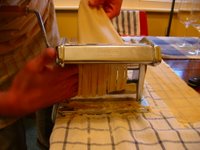Tomato soup is a quite popular lunch treat in England - at least the tinned variety is certainly very common! This has excited our curiosity about this dish, and for some time we kept our eyes peeled for interesting recipes for the real kind of tomato soup: the one that does not come out of a can. We have a Jamie Oliver book that features such a recipe, but for some reason we never felt really compelled to trying it out. To summarise, the whole thing has been in the back of our minds for some time.
One of these days I stepped into a Border's and as usually browsed through the wine/gourmet/cookery magazines. One in particular caught my attention:
Saveur. It featured an article about Buffalo wings, a dish we had tried just a few days before, but also seemed to have several recipes/articles worthy of a more careful reading. I decided to buy it. Inside there was this interesting article about Florence trattorias, and with it came a recipe for a sort of tomato soup:
pappa al pomodoro. It seems to be a very typical Tuscan dish, there are tons of recipes for this soup on the web. The one featured in the magazine is somewhat different from most we saw, and apparently it's this soup that is served at a trattoria called
Coco Lezzone. We strongly recommend it! The recipe we are going to write down is the one we actually implemented, obviously a slight variation on what is described in the magazine...
Ingredients:
-4 tins of good-quality plum tomatoes
-2 leeks, white and pale green part only, washed and finely chopped
- a couple of slices of stale bread (the rougher the better)
-1 cube of organic chicken broth (sorry!)
-2 cloves of garlic, peeled and finely chopped
-olive oil, salt, pepper, basil leaves
In a Le Creuset-type pot, heat a few slugs of olive oil. When the oil is hot, add the garlic and let it sizzle until it loses the rawness. Next, add the leeks, turn the heat down and let them slowly sweat, stirring often. No rush, the slower the better. Once the leeks are nice and cooked, add the tomatoes. What I do is to make sure the rougher part of each tomato is discarded, and I sort of squeeze each tomato in my hand so that it goes into the pot almost as a paste. I used the seeds and the juice also. Dissolve the cube of organic chicken stock in 1/2 a liter of boiling water and add this stock to the pot. Turn the heat up to get to the boiling point, and then turn it down and let the soup simmer for a good 30-45 minutes until everything has fallen apart and looks like a very nice pasta sauce. Take the pot from the heat source and add the bread broken in small pieces, pushing it inside the soup. Wait for an extra 30 minutes or so, until the bread has absorbed all the moisture. At that point, whisk the soup vigorously until it looks like porridge. Season with salt and pepper, add the basil leaves finely chopped, perhaps a bit more oil, reheat gently and serve:









 quite a lot of recipes for this on the web, the one we use is inspired in all of them! It's hard to detect the presence of the beetroot in the final cake --- but it's there. There's this earthy aftertaste, reminiscent of clay, something hard to explain. The beetroot certainly prevents the cake from drying out, keeps it nice and moist. This is the kind of cake that improves quite a bit with keeping, somehow the beetroot's presence becomes more evident as time progresses.
quite a lot of recipes for this on the web, the one we use is inspired in all of them! It's hard to detect the presence of the beetroot in the final cake --- but it's there. There's this earthy aftertaste, reminiscent of clay, something hard to explain. The beetroot certainly prevents the cake from drying out, keeps it nice and moist. This is the kind of cake that improves quite a bit with keeping, somehow the beetroot's presence becomes more evident as time progresses.
 Ingredients:
Ingredients:
